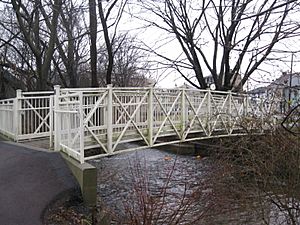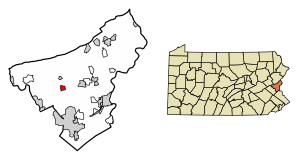Bath, Pennsylvania facts for kids
Quick facts for kids
Bath, Pennsylvania
|
||
|---|---|---|
|
Borough
|
||

Bath, Pennsylvania in December 2009
|
||
|
||
| Motto(s):
History, Nestled with Friendship
|
||

Location of Bath in Northampton County, Pennsylvania (left) and of Northampton County in Pennsylvania (right)
|
||
| Country | ||
| State | ||
| County | Northampton | |
| Founded | 1737 | |
| Named for | Bath, Somerset, England | |
| Area | ||
| • Borough | 0.91 sq mi (2.36 km2) | |
| • Land | 0.90 sq mi (2.34 km2) | |
| • Water | 0.01 sq mi (0.02 km2) | |
| Elevation | 432 ft (132 m) | |
| Population
(2020)
|
||
| • Borough | 2,682 | |
| • Density | 2,947/sq mi (1,138/km2) | |
| • Metro | 865,310 (US: 68th) | |
| Time zone | UTC-5 (EST) | |
| • Summer (DST) | UTC-4 (EDT) | |
| ZIP Code |
18014
|
|
| Area code(s) | 610 and 484 | |
| FIPS code | 42-04432 | |
| Primary airport | Lehigh Valley International Airport | |
| Major hospital | Lehigh Valley Hospital–Cedar Crest | |
| School district | Northampton Area | |
| Website | Borough Website | |
Bath is a small town, called a borough, in Northampton County, Pennsylvania. In 2020, about 2,808 people lived there. It's part of the larger Lehigh Valley area, which is home to over 860,000 people.
Contents
History of Bath
Bath is located near the start of the Monocacy Creek. This area in the Lehigh Valley used to be full of farms. Before European settlers arrived, the Lenape Indigenous tribe lived here.
How Bath Was Founded
Bath was first settled in 1728 by people from Scotland and Ireland. This happened before the American Revolution. It was the first settlement by white people in the "Forks of the Delaware River". The town was named after Bath, Somerset, England. Margaret DeLancey, whose father, William Allen, was a high-ranking officer, sold land here in the 1700s.
On March 3, 1737, Daniel Craig bought 247 acres of land that is now part of Bath. This land stretched from Chestnut Street to the north of Northampton Street. William Allen later gave most of Bath's land to his son, Andrew, in 1776. This was the same year the Declaration of Independence was signed in Philadelphia, declaring America's freedom from British rule. Andrew Allen then sold 150 acres to John Lattimore. Today, Bath is about 576 acres, which is less than one square mile.
Fort Ralston: A Historic Blockhouse
Southeast of Bath, a French and Indian War blockhouse was built to protect the area from attacks. It was called Fort Ralston, after the farmer whose land it was on. It was also known as Brown's Fort. The fort was built in 1755 but was probably left empty by the late 1760s. Its old ruins can still be seen in a field near Airport Road and Nor-Bath Blvd. These ruins include small underground rooms. Only one of the original buildings remains.
Recent History and Community Efforts
On August 18, 2012, Bath celebrated its 275th birthday! In 1999, the Bath Business and Community Partnership (BBCP) was started. This group works to make the town better. They help make Bath greener, organize volunteers, and improve the local economy.
Geography of Bath
Bath is located at 40°43′36″N 75°23′25″W / 40.72667°N 75.39028°W. It covers about 0.9 square miles, and all of it is land. Bath is about 6 miles north of Bethlehem and 4 miles west of Nazareth.
It is also about 100 miles southwest of New York City and 60 miles northwest of Philadelphia. Bath is near Wind Gap and the Delaware and Lehigh water gaps. The town's elevation is about 432 feet above sea level. Bath has many hills and steep roads.
Natural Features
There are two hills in Bath: Hawk Mountain in the northeast and Siegfried Hill in the southwest. Siegfried Hill has been partly dug out for quarries. The Monocacy Creek, which flows into the Lehigh River, runs through the center of town. A small park is located around the creek between Main and Northampton streets. The East Branch Monocacy also flows through Bath until it joins the main creek.
Other water areas include Penn-Dixie pond, which is what's left of an old quarry. There are also quarries at Keystone Cement and many small ponds on the edge of town. Many mills used to operate here, powered by the Monocacy Creek. Race and Mill streets are named after these old mills.
Bath sits on layers of shale, limestone, and slate. The area also has a lot of iron. Using limestone and slate from around Bath has been a big industry for the town for a long time. Keystone Cement Co. has the largest amount of limestone in the Lehigh Valley cement area.
People of Bath
| Historical population | |||
|---|---|---|---|
| Census | Pop. | %± | |
| 1860 | 486 | — | |
| 1870 | 707 | 45.5% | |
| 1880 | 698 | −1.3% | |
| 1890 | 723 | 3.6% | |
| 1900 | 731 | 1.1% | |
| 1910 | 1,057 | 44.6% | |
| 1920 | 1,401 | 32.5% | |
| 1930 | 1,625 | 16.0% | |
| 1940 | 1,720 | 5.8% | |
| 1950 | 1,824 | 6.0% | |
| 1960 | 1,736 | −4.8% | |
| 1970 | 1,829 | 5.4% | |
| 1980 | 1,953 | 6.8% | |
| 1990 | 2,358 | 20.7% | |
| 2000 | 2,678 | 13.6% | |
| 2010 | 2,693 | 0.6% | |
| 2020 | 2,808 | 4.3% | |
| Sources: | |||
In 2021, about 2,682 people lived in Bath. This was a small decrease from 2010. There were slightly more males (50.1%) than females (49.9%). The town had about 2,947 people per square mile.
Most residents (79%) are White. About 6.6% are African American, 0.3% are Native American, and 0.5% are Asian. About 8.2% of people are from two or more races.
Most people over 25 (90.2%) have at least a high school diploma. About 18.9% have a bachelor's degree or higher. In 2020, the average household income was $53,250. The average value for a house or condo was $170,900, and the average rent was $1,189.
Community Life
Bath has many groups that help the community. These include the American Legion Eckley E. Patch Post 470 and the Bath Business and Community Partnership (BBCP). There are also youth clubs, improvement committees, and the Bath Museum Committee.
Other groups include the Bath Lions Club, the Governor Wolf Historical Society, and the Mid-County Senior Center. The Monocacy Creek Watershed Association is also active. They help protect the Monocacy Creek by organizing cleanups and other conservation efforts.
Parks and Recreation
Bath has four main recreational areas:
- Volunteer Firefighter's Park
- Keystone Park
- Ciff Cowling Field
- Carl L. Rehrig Park
Places to Visit
- Bath Farmer's Market: This market is next to the American Legion on Route 329. It sells fresh local products like vegetables, baked goods, and handmade soap. It's open from May to September on Fridays from 3-7 p.m.
- The Wesselhoeft House: This house on Chestnut Street was the first school for a type of medicine called homeopathy, started in 1829.
- The Bath Museum: Located at the municipal building, this museum displays items from the 1800s and later. It is open on the third Saturday of each month from 10:00 A.M. to 2:00 P.M., except in December when it's open on the first Saturday.
- The Daniel Steckel House: This historic house was added to the National Register of Historic Places in 1982. Daniel Steckel built it for his wife in 1804. He was an important person in Bath in the 1800s and lived to be 101 years old. The house is now a bed-and-breakfast.
- Graver Arboretum: Owned by Muhlenberg College, this arboretum in Bath has free entry. It features native and rare trees, along with many types of flowers.
- Sacred Heart of Jesus Parish: This is a Catholic church on Washington Street. After its school closed, Kolbe Academy Recovery High School opened at this location.
- Malta Hall: This building at 143 E Main Street was built in 1855. It has been many things over the years, including a marble workshop, a high school, a Scout hall, and a public library. It is now a private home.
Getting Around Bath
In 2007, Bath had about 10.79 miles of public roads. The Pennsylvania Department of Transportation (PennDOT) maintained 4.65 miles, and the borough maintained 6.14 miles.
Several main roads pass through Bath:
- Pennsylvania Route 248 (PA 248) runs east-west through the borough.
- Pennsylvania Route 329 (PA 329) starts at PA 248 and heads southwest.
- Pennsylvania Route 512 (PA 512) runs north-south.
- Pennsylvania Route 987 (PA 987) also runs north-south and shares parts of its route with PA 329 and PA 248.
Bath once had a trolley line that went to Nazareth. There was also the Northampton and Bath railroad, a local line that ran between Bath and Northampton for 8 miles. This railroad closed in 1978, and its path is now used for biking and walking. One mile of the track is still used by local businesses.
Education in Bath
The borough is part of the Northampton Area School District. Students in grades nine through 12 attend Northampton Area High School in Northampton.
Bath is also home to George Wolf Elementary School, which opened in 1968. It has many classrooms, a library, and a music room. The school is named after George Wolf, a local resident who was the Governor of Pennsylvania from 1829 to 1835. He is known as the "father of the free public school system" in Pennsylvania because he worked hard to pass the Free School Act of 1834. His original Wolf Academy is about one mile from the school.
As of 2022, Kolbe Academy Recovery High School is located on Washington Street in Bath. It is the first Catholic recovery school in the United States.
Media
The Home News is a weekly newspaper that focuses on news from Bath and the towns around it. It first started being published in 1942.
Notable People
- Matt Christopher (1917-1997), a famous children's author.
- Arthur Granville Dewalt (1854-1931), who served as a U.S. Congressman.
- David Engleman (1835-1913), who was a Pennsylvania State Senator and Representative.
See also
 In Spanish: Bath (Pensilvania) para niños
In Spanish: Bath (Pensilvania) para niños





